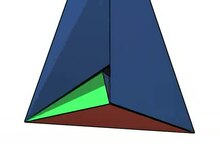Császár polyhedron
| Császár polyhedron | |
|---|---|
|
An animation of the Császár polyhedron being rotated and unfolded
|
|
| Type | Toroidal polyhedron |
| Faces | 14 triangles |
| Edges | 21 |
| Vertices | 7 |
| χ | 0 (Genus 1) |
| Vertex configuration | 3.3.3.3.3.3 |
| Symmetry group | C1, [ ]+, (11) |
| Dual polyhedron | Szilassi polyhedron |
| Properties | Nonconvex |
In geometry, the Császár polyhedron (Hungarian pronunciation: [ˈtʃaːsaːr]) is a nonconvex polyhedron, topologically a toroid, with 14 triangular faces.
This polyhedron has no diagonals; every pair of vertices is connected by an edge. The seven vertices and 21 edges of the Császár polyhedron form an embedding of the complete graph onto a topological torus. Of the 35 possible triangles from vertices of the polyhedron, only 14 are faces.
The tetrahedron and the Császár polyhedron are the only two known polyhedra (having a manifold boundary) without any diagonals: every two vertices of the polygon are connected by an edge, so there is no line segment between two vertices that does not lie on the polyhedron boundary. That is, the vertices and edges of the Császár polyhedron form a complete graph.
If the boundary of a polyhedron with v vertices forms a surface with h holes, in such a way that every pair of vertices is connected by an edge, it follows by some manipulation of the Euler characteristic that
This equation is satisfied for the tetrahedron with h = 0 and v = 4, and for the Császár polyhedron with h = 1 and v = 7. The next possible solution, h = 6 and v = 12, would correspond to a polyhedron with 44 faces and 66 edges, but it is not realizable as a polyhedron. It is not known whether such a polyhedron exists with a higher genus (Ziegler 2008).
...
Wikipedia


